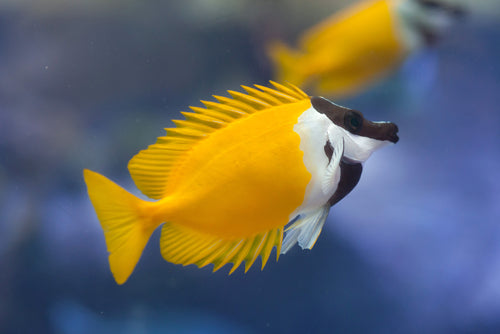|
View Marine Fish Compatibility Chart
Please note the spines can deliver a venom that is similar to a bee's sting. Although not common an allergic reaction could potentially make it life threatening. It is not common to be poked by these spines but you should use extra caution while handling the fish and transferring it from the shipping bag to your aquarium.
Siganus vulpinus
The Foxface Lo Rabbitfish, scientifically known as Siganus vulpinus, is a captivating and popular fish species that belongs to the Siganidae family. This marine beauty is admired for its unique body shape, vibrant colors, and striking facial features, resembling that of a fox.
Originating from the Indo-Pacific region, particularly found in the coral reefs of the Indian Ocean and the Pacific Ocean, the Foxface Lo Rabbitfish showcases a captivating combination of bright yellow and black hues. Its body is laterally compressed and oval-shaped, with a distinctive elongated snout and large, protruding eyes.
This species is relatively larger in size compared to other rabbitfish, reaching an average length of around 8-10 inches (20-25 cm) when fully grown. Its body is predominantly yellow, with striking black markings on its face, dorsal fin, and tail. The black markings often form a unique "mask" pattern around its eyes, resembling the facial features of a fox.
The Foxface Lo Rabbitfish is known for its peaceful temperament and active swimming behavior, gracefully gliding through the water column. It requires ample swimming space and a well-established reef or marine aquarium with plenty of hiding spots and live rock formations to mimic its natural habitat.
When it comes to feeding, the Foxface Lo Rabbitfish is primarily herbivorous, feeding on various types of algae and seaweed in the wild. In a home aquarium, it should be provided with a varied diet consisting of high-quality marine-based foods, such as algae sheets, spirulina flakes, and other herbivore pellets or flakes. Supplementing their diet with fresh vegetables, like blanched spinach or seaweed, can also be beneficial for their overall health and well-being.
Providing optimal water conditions is crucial for the well-being of the Foxface Lo Rabbitfish. They prefer a well-maintained aquarium with stable water parameters, including a temperature range of 72-78°F (22-26°C) and a pH level of 8.1-8.4. Regular water changes and the use of a good filtration system are essential to maintain water quality.
While the Foxface Lo Rabbitfish is generally peaceful, it may exhibit territorial behavior towards similar-looking species or other rabbitfish. It is recommended to introduce them to the aquarium as the last addition to minimize aggression. Keeping only one Foxface Lo Rabbitfish per aquarium is usually advised, unless you have a very large tank with ample swimming and territorial space.
Overall, the Foxface Lo Rabbitfish is a captivating and highly desirable addition to any reef or marine aquarium. Its unique body shape, vibrant colors, and striking facial features make it a standout species and a favorite among aquarium enthusiasts. With proper care, a suitable environment, and a well-balanced diet, the Foxface Lo Rabbitfish can thrive and become a stunning centerpiece, adding beauty and elegance to your underwater world.
Caution - The Foxface's dorsal spines are venomous which deters his predators. Although peaceful, he will flare his dorsal fin when startled or threatened and you should be mindful of this while feeding or when placing corals/settings rocks. As long as you are aware of the Foxface's location within your tank, and you don't suddenly place your hand near him, there is limited chance for direct contact. Be cautious while hand feeding.
|

